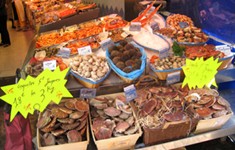
“Seafood markets are very much conditioned by the state of the economy in these countries, and whilst the recent and fragile rise of the Euro against the USD offers hope to seafood operators — especially those importing seafood from third countries and paying in USD — many uncertainties remain,” said Correard.
He finds the Spanish and Italian markets doomed to short-term vision, in which it is difficult to detect any evidence of recovery. Refuge in more basic products, in cheaper alternatives species and in canned seafood, all show the fragility of the market. The countries’ fishing and fish processing sectors all face increasing production costs brought on by the economic situation, and continue to be hampered by unfavorable national regulations, including a 25 percent increase in the rate of VAT on seafood in Spain in 2012, and changes to the social security system for artisanal fishers and fish workers in Italy.
Imports have been affected, with tilapia fillets to Spain for example dropping from 11,400 metric tons (MT) in 2011 to 6,200 in 2012, and sales of chilled cheaper species such as farmed sea bream and seabass, taking the place of European Hake, monkfish and turbot.
With seafood consumption in both countries continuing to decline, one of the measures put in place in 2012 to change consumer habits was the promotion of products from national fisheries, such as the “Enjoy eating fish campaign” launched by ANMAPE and CEPESCA in Spain, and the “Forgotten fish species from the Adriatic Sea” in Italy. However, such feel good campaigns were weakened by austerity measures imposed by Europe and the effect of its banking systems on the domestic fish production sector.
In France the situation is rather different and Correard points out that the seafood sector has survived better than in Spain and Italy. “It is much easier for a company to obtain finance from banks in France, and this has kept the seafood industry more buoyant,” he explained.
It is in this context that the French retail sector is setting up a new model of shopping that could pave the way for more modern food distribution channels in Europe.
Correard explains that consumer preference has moved away from big out of town hypermarkets to smaller in-town stores, which save them both travelling time and fuel costs. “In France, nearly 6,000 convenience stores have opened since 2011 and these so-called ‘proximity concepts’ have become the new levers for retail development,” he said.
In 2012 French retailers pushed this concept further, with the introduction of 100 “drive-through” distribution channels every month. Customers now have the option of picking up products ordered in advance on the internet, scanned on smart phones, or picked out at self-order kiosks. A recent study by Linéraires predicting that drive-throughs will be responsible for about 15 percent of annual growth in the food market in 2015 and represent a turnover of more than EUR 2 billion (USD, 2.7 billion).
With such developments comes the need for new convenience products and robust packaging, which are more attractive to consumers in an environment where physical contact with the product is disappearing. The challenge for processors is in reconciling conflicting expectations, namely fast shopping operations and controlled budget on one side, with a wide choice of desirable products on the other.
It is expected that the new distribution channels may accelerate the reorganization of traditional in-store fresh fish counters, with an increasing offering of vacuum packed and MAP packed chilled products making seafood easier to handle and transport, and offering a longer shelf live than fresh products. A recent survey by FranceAgriMer showed that acceptance of pre-packed seafood products in stores has already increased significantly.
“The survivors of the current crisis will be those companies able to adapt and innovate and it will be interesting to see how the market shapes up over the next twelve months,” said Correard.





